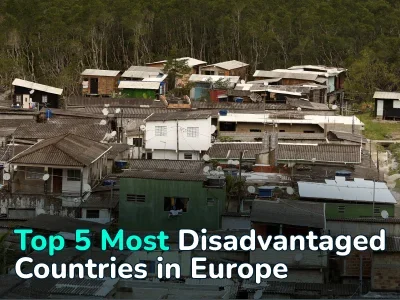
Studying in Poland: Education System, Admission and Prices for International Students
Poland ranks sixth in Europe in terms of the number of international students. Each year, they account for around 8–10% of all students in the country, although at the time of Poland’s accession to the EU in 2004, this figure was only 0.5%.
Such attractiveness is explained by the affordable cost of education, especially compared to Western Europe. At the same time, Polish higher education fully complies with the Bologna Process standards, which means that a Polish diploma is just as valid as those from other European countries.
In this article, we will explore the structure of the education system in Poland and examine its key components.
The Education System in Poland
Education in Poland dates back to the Middle Ages, when in 1364 King Casimir III the Great founded the Jagiellonian University in Kraków. The University of Warsaw, now more popular, was established much later, in 1816.
Modern educational programs in Poland cover all stages, from preschool (przedszkole, kindergarten in Poland) to higher education (szkolnictwo wyższe). They follow the Bologna Process — the European standardization framework ensuring qualification compatibility and international recognition of diplomas both within and beyond the EU.
One important feature of the Polish system is terminology: high schools, technical schools, and vocational schools are all referred to as szkoła («school»). For foreigners, this may sound unusual, since in other countries such institutions are more comparable to colleges or vocational schools rather than schools in the usual sense.
Education in Poland is divided into four levels:
- Preschool (ages 3–6).
- Primary (ages 7–15).
- Secondary (ages 15–19).
- Higher education, including doctoral, bachelor’s, and master’s in Poland.
Advantages of studying in Poland:
- International recognition. Polish universities are ranked within the world’s top 400, and their diplomas are recognized in the EU, the USA, and beyond.
- Affordability. Tuition fees range from €2000 to €6000 per year, while living expenses average €400—800 per month. This is significantly lower than in the UK, where tuition alone costs €13,000—44,000 annually.
- Practical orientation. Programs at technical schools and universities in Poland, especially in IT and engineering, are tailored to labor market needs. As a result, about 85% of graduates find employment within a year.
- International integration. Studying English in Poland is not only available but increasingly popular. Universities are expanding English-language programs every year and offer preparatory language and adaptation courses.
Disadvantages of studying in Poland:
- Language barrier. Poland’s education system for international students allows tuition-free studies only for those who can present a Polish language certificate at the B2 or C1 level. Only about 25% of programs at public universities are available in English.
- Quality differences. Public institutions generally have higher reputations than private ones but tend to be less flexible in teaching methods.
- Limited scholarship opportunities. While Poland scholarship programs exist, competition is intense — fewer than 10% of international students receive full financial support.
Preschool Education in Poland
Preschool education in Poland (przedszkole) is designed for children aged 3 to 6, although some institutions accept children from the age of 2.5. Essentially, it represents the first stage of the education system, with a strong focus on developing social, emotional, and basic academic skills. Since 2017, attendance in preparatory classes (zerówka) has been mandatory for 6-year-olds, ensuring readiness for primary school (szkoła podstawowa).
Types of Polish kindergartens:
- Public (publiczne). Operated by local authorities, these institutions provide free education for children aged 5–6. For younger children (ages 3–4), parents typically pay €25—75 per month.
- Private (niepubliczne). These kindergartens offer more flexible curricula and additional activities. Tuition fees are higher than in public ones, ranging from €120 to €350 per month.
- Religious. Run by religious organizations, predominantly Catholic.
Polish preschools emphasize learning through play, combining knowledge acquisition with skill development. Key areas include speech development, motor skills, early numeracy and literacy, as well as social interaction. In preparatory classes, children learn the alphabet, numbers, and basic writing skills. Programs place particular emphasis on mastering the Polish language, though some institutions, especially private ones also offer classes in English.
Primary Education in Poland
Primary education in Poland is compulsory for children aged 7 to 15. It lasts for 8 years and is divided into lower and upper grades.
- Lower grades (1–3). Focus on developing reading, writing, numeracy, as well as providing a foundation in mathematics and natural sciences. At this stage, in addition to Polish language instruction, students begin studying their first foreign language — usually English.
- Upper grades (4–8). The curriculum broadens to include history, civics, biology, physics, chemistry, geography, a second foreign language (often German or French), and computer science.
At the end of primary school, students take a final exam in Polish, mathematics, and a foreign language. The results play a key role in determining admission to further education, such as a general secondary school (liceum), technical school (technikum), or vocational school.
Grading system in Poland schools use a six-point grading scale:
- 6 (celujący): outstanding.
- 5 (bardzo dobry): very good.
- 4 (dobry): good.
- 3 (dostateczny): satisfactory.
- 2 (dopuszczający): minimally acceptable.
- 1 (niedostateczny): unsatisfactory.
For children who do not speak Polish, schools provide free Polish language courses for up to 5 hours per week during the first year. In major cities, there are also dedicated classes for foreign students.
Secondary Education in Poland
Secondary education in Poland covers students aged 15 to 19 and allows them to choose either an academic or a vocational pathway.
Types of secondary schools in Poland:
- General secondary school (liceum ogólnokształcące). Duration: 4 years. Focused on academic preparation for higher education. Students select a specialization in humanities, natural sciences, or mathematics with an in-depth study of 2–3 core subjects.
- Technical school (technikum). Duration: 5 years. Combines academic education with vocational training. Graduates receive a professional diploma (technik) and remain eligible for university admission.
- Vocational school (szkoła branżowa). Duration: 3 years (Stage I), with an option to continue for an additional 2 years (Stage II). Oriented towards practical skills for immediate employment (e.g., cook, mechanic, hairdresser).
All students must pass the final Matura examination (egzamin maturalny), as this is one of the key requirements to study in Poland at the higher education level. The Matura consists of compulsory written exams in Polish, mathematics, and a foreign language, along with oral assessments and additional elective subjects.
Higher Education in Poland
Higher education in Poland is overseen by the Ministry of Science and Higher Education. Thanks to the Bologna framework, Polish degrees are highly regarded not only across the EU but also in the UK and the United States.
Levels of higher education in Poland:
- Bachelor’s degree (licencjat / inżynier). Typically 3 years for humanities, social sciences, and economics, and 3.5–4 years for technical, engineering, and IT fields. Programs include lectures, seminars, and practical training, culminating in a final thesis (praca dyplomowa).
- Master’s degree (magister). Usually 1.5–2 years for bachelor’s graduates. The requirements for a master’s in Poland include a recognized bachelor’s diploma, language proficiency (Polish or English), and, in some cases, entrance exams. Studies place greater emphasis on research and professional skill development, with the program concluding in a master’s thesis (praca magisterska).
- Long-cycle master’s programs (jednolite studia magisterskie). A specific format that combines bachelor’s and master’s studies into a single continuous program lasting 5–6 years. Typical for disciplines such as medicine, dentistry, law, psychology, and pharmacy. These programs put strong emphasis on practical training and professional application.
- Doctoral studies (doktor). Standard duration is 3–4 years, sometimes up to 5. The focus is on independent research, academic publications, and the completion of a doctoral dissertation (praca doktorska).
- Postgraduate studies (studia podyplomowe). These programs usually last 1–2 years (2–4 semesters) and are not equivalent to full academic degrees. Instead, they serve as short-term courses aimed at professional development or retraining.
Before applying to a Poland international university, it is important to understand the categories of higher education institutions available in the country:
- Universities (uniwersytety). Multidisciplinary institutions offering programs in the humanities, social sciences, natural sciences, and exact sciences.
- Technical universities (politechniki). Specializing in engineering, technical, and IT fields, with a strong focus on practical training.
- Academies (akademie). Specialized institutions dedicated to specific fields such as medicine, the arts, music, or economics.
- Private institutions (uczelnie niepubliczne). Offer flexible study programs, with the notable advantage that nearly all programs are available in English.
Approximately 75% of programs at public universities are taught in Polish, and tuition-free study is available only to applicants who can present a Polish language certificate at B2 level (for bachelor’s programs) or C1 level (for master’s and doctoral studies).
Polish language courses are organized both by universities and by private language schools. They usually last 6–12 months and cost, on average, around €2000 per year. This is a reasonable investment, since studying in English not only comes with limited program availability but also significantly higher tuition fees — between €3000 and €15,000 per year, compared to €2000—6000 for programs taught in Polish.
Best universities in Poland (global position):
- University of Warsaw — #284, strong in humanities.
- Jagiellonian University (Kraków) — #304, notable in medicine and law.
- Warsaw University of Technology — #501–510, strong in IT and engineering.
- Adam Mickiewicz University (Poznań) — #731–740, recognized in biology.
- University of Gdańsk — #801–850, notable in ecology.
Foreign students can also obtain higher education remotely. Private universities in Poland, such as WSB Merito and Kozminski Academy, offer e-learning programs and distance education options.
Cost of Education in Poland
Education in Poland is relatively affordable compared to other European countries. For Polish citizens and holders of the Karta Polaka (Pole’s Card), many programs are entirely free of charge.
- Preschool education. Free for children aged 5–6, provided they attend up to 5 hours per day. For younger children (ages 3–4), the fee is €25—75 per month. In private Polish kindergartens, tuition ranges from €120—350 per month and in larger cities can reach up to €470.
- Primary education (szkoła podstawowa). Fully free for all children, including foreigners, at public schools. Private schools, however, charge €1200—4700 per year, often offering instruction in English.
- Secondary education. Public schools are tuition-free, while private institutions charge €2300—5800 annually. International schools in Poland with English-language programs are more expensive, reaching up to €7000 per year.
- Higher education. Free for Polish citizens, holders of the Karta Polaka, EU citizens, and foreigners who possess a C1-level Polish language certificate, a residence card (karta pobytu), or refugee status. For other international students, tuition fees typically range from €2000 to €15,000 per year, depending on the program and the language of instruction.
Polish Language Courses
The main requirement for free study in Poland for international students is to know Polish. Language courses are available both in Poland and abroad.
The most popular option for foreigners is the one-year preparatory programs (kursy przygotowawcze), usually offered by universities to prepare students directly for admission. These programs last 9–12 months (600–800 contact hours) and focus on academic Polish, culminating in exams at the B2 or C1 proficiency level.
There are also summer intensive courses lasting 4–8 weeks, which are better suited for reaching a basic level (A1—A2). As an alternative, evening or modular courses are available, designed for working students or expatriates who need to gradually improve their proficiency.
Frequently Asked Questions About Education in Poland
What are the top universities in Poland for international students?
Several Polish universities are consistently ranked in the world’s top 500–800 and offer a wide range of programs in English, making them attractive to international students. Here is the Poland university list for international students:
- University of Warsaw (Uniwersytet Warszawski).
- Jagiellonian University, Kraków (Uniwersytet Jagielloński).
- Warsaw University of Technology (Politechnika Warszawska).
- AGH University of Kraków (University of Science and Technology).
- Poznań University of Medical Sciences.
- Wrocław University of Science and Technology.
How to apply to universities in Poland?
Admission to Polish universities is based on a high school diploma and final exam results (Matura or its equivalent). Typically, proficiency in Polish at the B1/B2 level is required, or English for English-language programs. Many universities also offer preparatory language courses for foreigners to help them get ready for academic study and entrance exams.
How much does Poland study cost?
Tuition for international students averages €2000–6000 per year, while living expenses are around €400–800 per month. To save money, students may opt for part-time (zaoczne) Poland studies, which take place in weekend modules and are usually cheaper than full-time programs, yet the diploma holds the same validity. In addition, many universities — both public and private — are expanding online formats, especially for humanities and business fields.
What are the main Poland university scholarship opportunities for international students?
Poland's university scholarship programs are available through both national initiatives and individual universities. The largest scheme is the Polish Government Scholarship (NAWA), which supports students from selected countries in Eastern Europe, Asia, Africa, and Latin America. It usually covers tuition fees, a monthly stipend, and sometimes accommodation.
In addition, many public universities — such as the University of Warsaw, Jagiellonian University, and Warsaw University of Technology — offer their own merit-based and need-based awards. These scholarships Poland programs are often competitive and require strong academic records or proof of financial need.
The Erasmus+ program is another major channel for funding, allowing international students from EU and partner countries to study in Poland with full or partial financial support. Some cities, like Kraków and Wrocław, also provide local government scholarships for outstanding foreign students.
Is it possible to study in Poland without the Karta Polaka?
The Karta Polaka is not mandatory for admission to Polish universities. Without it, applicants are considered international students and must pay tuition fees. However, holding the Karta Polaka provides access to free education at public universities and eligibility for social scholarships.
What schools in Poland for international students are the most popular?
In major cities like Warsaw, Kraków, and Wrocław, international schools offer curricula in English, French, or German, including IB (International Baccalaureate) programs. Popular examples are the American School of Warsaw, British International School Kraków, and the International School of Wrocław. These institutions serve both expat families and Polish parents seeking bilingual education for their children.
For families with younger kids, it is also possible to find an international preschool in Warsaw, which provides bilingual early education and a smooth transition into international primary schools.
Author
I write informative articles about real estate, investments, job opportunities, taxes, etc.























